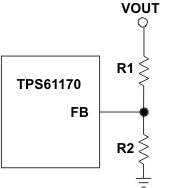SLVSAX2B September 2011 – June 2020 TPS61170-Q1
PRODUCTION DATA.
- 1 Features
- 2 Applications
- 3 Description
- 4 Revision History
- 5 Pin Configuration and Functions
- 6 Specifications
- 7 Detailed Description
-
8 Application and Implementation
- 8.1 Application Information
- 8.2 Typical Applications
- 9 Power Supply Recommendations
- 10Layout
- 11Device and Documentation Support
- 12Mechanical, Packaging, and Orderable Information
Package Options
Mechanical Data (Package|Pins)
- DRV|6
Thermal pad, mechanical data (Package|Pins)
- DRV|6
Orderable Information
8.2.1.2.1 Program Output Voltage
 Figure 16. Program Output Voltage
Figure 16. Program Output Voltage To program the output voltage, select the values of R1 and R2 (see Figure 16) according to Equation 2.
Equation 2. 

Considering the leakage current through the resistor divider and noise decoupling to FB pin, an optimum value for R2 is approximately 10 k. The output voltage tolerance depends on the accuracy of the reference voltage and the tolerance of R1 and R2.